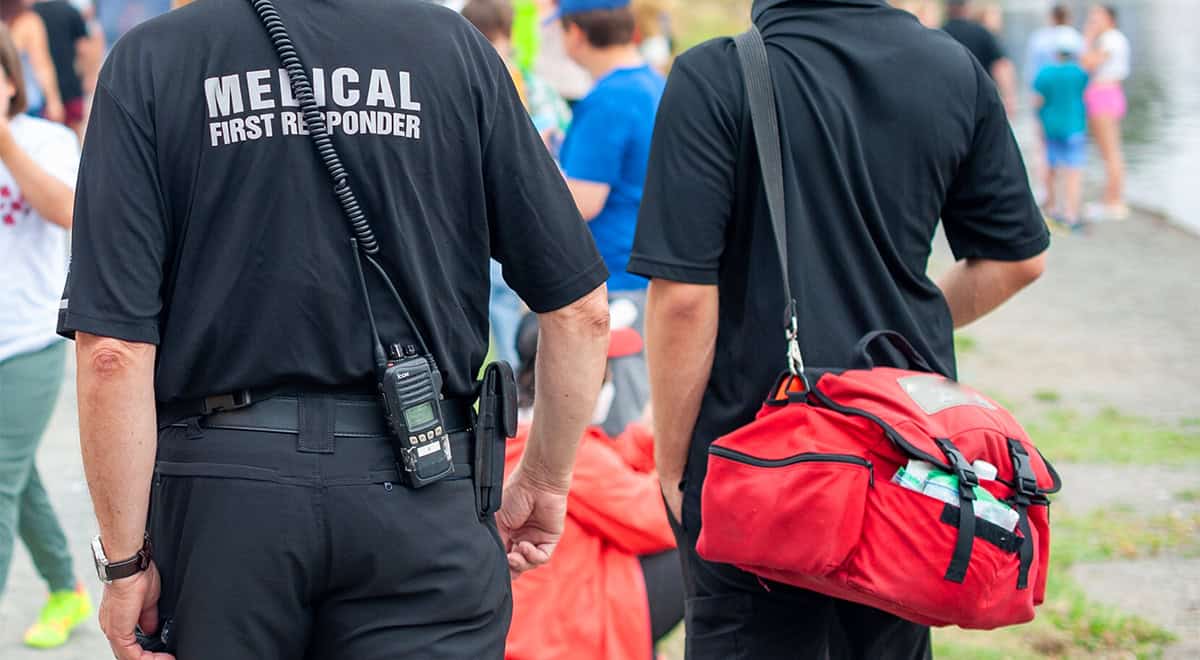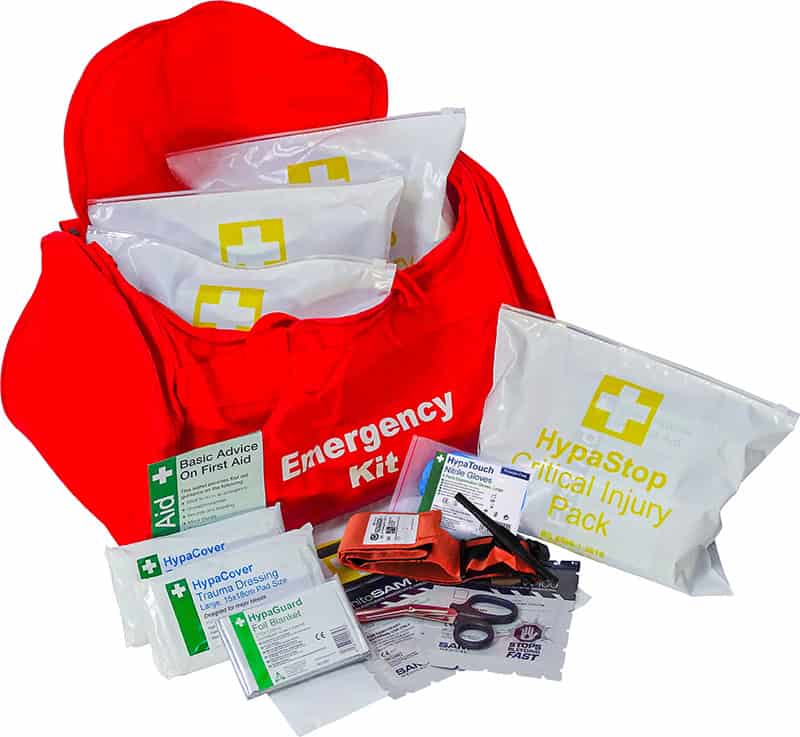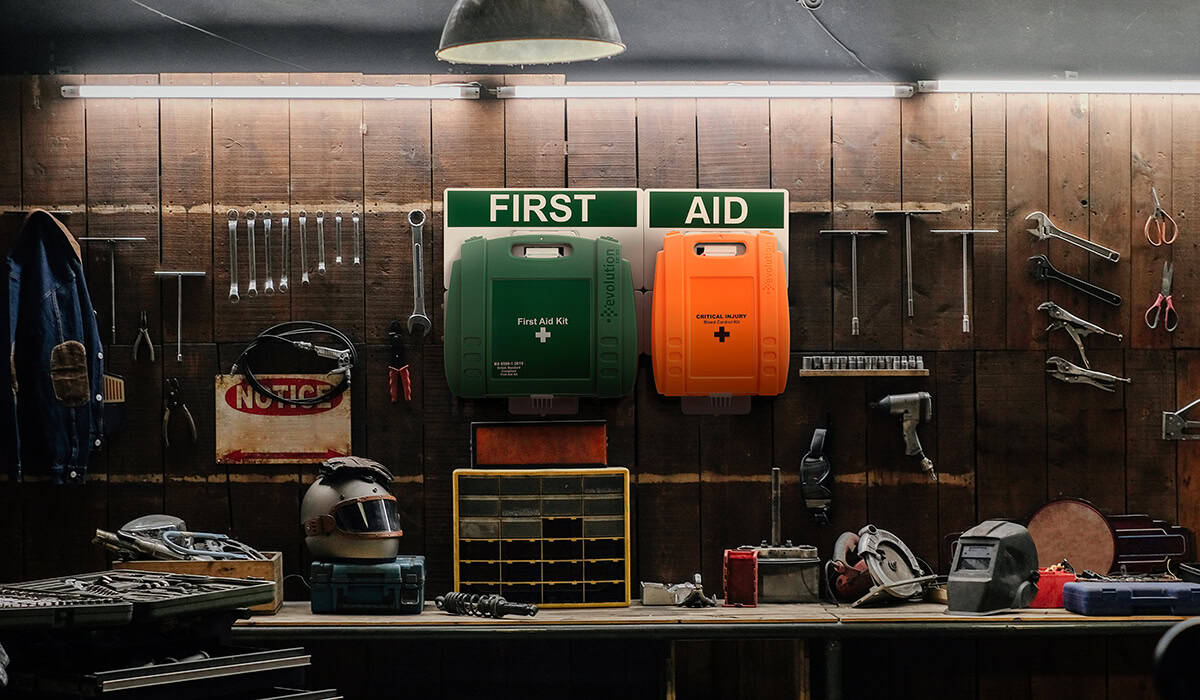
PAcT kits are first aid kits that have been specially designed to provide equipment suitable for immediate, life-threatening situations unlike regular first aid kits which are designed primarily for minor injuries.
They are ideal for situations where the casualty has a period of time between the accident and when emergency services arrive that could cost them their life.
Using public access trauma first aid kits

PAcT kits are designed for the general public to use with no first aid training in an emergency situation.
The goal is to make these kits publicly available, similar to AEDs, with basic first aid advice so that even people without prior training can use them.
While general first aid kits can be either British Standard or HSE, which is decided by your business’s needs, trauma kits can be used in a wide variety of emergency situations which is why there is some variation in their contents. For example, PAcT Kits can be used in cases of critical injuries, such as critical bleeding, emergency evacuation and terrorist attacks.
Regulations and recommendations
While PAcT kits aren’t yet a legal requirement for businesses and public spaces, it is down to the business’ risk assessment to determine whether they require one to be compliant under the HSE’s legislation of providing “adequate and appropriate” first aid equipment.In terms of keeping your PAcT kit fully stocked and ready for use, the recommendations remain the same as they would for a normal first aid kit. A lot of the supplies within the kits will have expiry dates that need to be checked regularly to ensure that your kit is fully operational.
Martyn's Law and PAcT kits
Martyn’s Law received its name from Martyn Hett, who lost his life in the Manchester Arena Attack. It has been created with the intention for venues to consider how they have prepared and how they would respond to an attack such as that happening in their location.Martyn's Law recently gained Royal Assent, making it an official part of English law. The legislations primary focus is that venues for over 200 people are reducing their vulnerability to attacks and ensuring that if one were to occur the venue is able to reduce the physical harm done.
As such, PAcT kits are a great way for public venues to prove that they have taken steps to prepare for every eventuality and can provide a quick response to mass casualty events where there may be a delay in getting medical attention.
What should a PAcT Kit contain?
 PAcT kits should contain enough equipment so that members of the public can be quickly treated for life-threatening injuries. for this reason, many of the contents will be similar to a trauma kit.
PAcT kits should contain enough equipment so that members of the public can be quickly treated for life-threatening injuries. for this reason, many of the contents will be similar to a trauma kit.There are several sizes that the PAcT kit could come in which will impact the number of supplies present, just like with our standard and professional critical injury packs. This means that you will need to decide which pack works best for you based upon your risk assessment.
A typical PAcT Kit should contain:
- Haemostatic dressings - Haemostatic dressings use a chemical process to speed up the clotting of wounds.
- Haemostatic granules - The haemostatic granules work in the same way as haemostatic dressing, using a chemical process to speed up the clotting, however, these granules are packed into the wounds instead of being placed onto them.
- Trauma dressings - A trauma dressing is a wound dressing designed to handle larger volumes of blood than normal.
- A tourniquet - Using a tourniquet is another way that you are able to stop major bleeds on a limb.
- Nitrile gloves - Nitrile gloves are a staple in every first aid kit as they prevent cross contamination both to the wound and the first aider.
- Foil blankets - Ideal for treating someone with a rapidly falling temperature, foil blankets work by trapping a person’s natural body heat.
- Face shield - Like the gloves, having a face shield on hand when performing CPR prevents the transfer of bacteria from the casualty to the first aider and vice versa.
- Clothing cutters - Just in case you need to get to a wound quickly but are unable to safely remove the clothing, clothing cutters are a must have.
Where should PAcT Kits be located?
A PAcT Kits should be located in a similar position to any other first aid kit, preferably wall-mounted where they are most likely to be needed according to a risk assessment. It is important to ensure that the kits are easily accessible and visible to all who pass through the area. These trauma kits should be available to both staff and visitors to a location during an emergency so should not be kept behind staff only doors, unless there are multiple kits on-site.A general recommendation is that workplaces store their kit in the entry way and venues such as theatres and stadiums, should have one in their ticket hall, so that the PAcT Kit can be used for incidents both inside and outside the venue.
The number of kits and the location of these kits will largely depend on what your risk assessment is telling you is best.

How to install a PAcT Kit
Trauma kits should be visible and positioned on a wall to make them as accessible as possible. As such, you will probably want to fit a bracket.For example, with kits like our Bleed Control Kit in a Nylon Bag, you may find that a simple hook bracket where you can hang the kit onto the wall by the handle would work best. Or, if you have one of our Evolution® kits, the correct sized bracket for that case has a quick release feature for emergencies.
Another way to install a PAcT kit is to have it in the same location as your other first aid kits. This is where the implementation of a First Aid Station would be ideal as this allows you to have not only a version of our trauma kits, but also a first aid kit and potentially a burns kit depending on the needs of your workplace.
Why purchase a trauma kit?
While they are not the equivalent of a first responder’s medical kit, trauma kits allow for emergency first aid to be carried out for severe issues. They are designed so that the supplies can preserve someone’s life until emergency services can reach them.Having a PAcT kit should be as commonplace as having an AED and Casualty transportation in public buildings, especially for workplaces and environments that are high risk such as construction sites, or where help may not be close by like in the agricultural industry.
Read our other blogs for more information on first aid or contact us for further advice and information on our products.
By Sarah Mason

